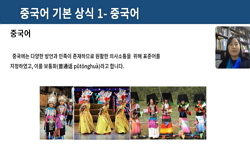The Hua-yi-yi-yu is a general name for the various wordbooks between the Chinese language and its neighbor languages compiled from the beginning of the Ming dynasty (1368~1644). It has broadly 4 different classes: 1. the Sino-Mongolian wordbook compil...
http://chineseinput.net/에서 pinyin(병음)방식으로 중국어를 변환할 수 있습니다.
변환된 중국어를 복사하여 사용하시면 됩니다.
- 中文 을 입력하시려면 zhongwen을 입력하시고 space를누르시면됩니다.
- 北京 을 입력하시려면 beijing을 입력하시고 space를 누르시면 됩니다.

The Uighur Word Materials in a Manuscript of Hua-yi-yi-yu (華夷譯語) in the Library of Seoul National University (3) = The Uighur Word Materials in a Manuscript of Hua-yi-yi-yu (華夷譯語) in the Library of Seoul National University (3)
한글로보기https://www.riss.kr/link?id=A82675470
- 저자
- 발행기관
- 학술지명
- 권호사항
-
발행연도
2011
-
작성언어
Korean
- 주제어
-
KDC
791
-
등재정보
KCI등재
-
자료형태
학술저널
- 발행기관 URL
-
수록면
121-138(18쪽)
- 제공처
- 소장기관
-
0
상세조회 -
0
다운로드
부가정보
다국어 초록 (Multilingual Abstract)
The Hua-yi-yi-yu is a general name for the various wordbooks between the Chinese language and its neighbor languages compiled from the beginning of the Ming dynasty (1368~1644). It has broadly 4 different classes: 1. the Sino-Mongolian wordbook compiled by Huo Yuan-Jie, Ma-sha-yi-hei, etc.; In this wordbook the Mongolian words were written in Chinese characters according to the transliteration rules in The Secret History of the Mongols. 2. the wordbooks which were compiled, continually reedited and added/reduced in Si-yi-guan; In the wordbooks of this class the words of each foreign language were not only transliterated in Chinese characters but written also in letters native to the language in question. 3. the wordbooks which were presumably compiled in Hui-tong-guan; In the wordbooks of this class the words of each foreign language were transliterated only in Chinese characters and the letters native to the language in question were not used. 4. the wordbooks which were compiled in Hui-tong- si-yi-guan, which was formed with the unification of Hui-tong-guan and Si-yi-guan in 1748. To the third class belongs the manuscript in the collection of the library of Seoul National University. It comprises the 8 volumes: (1) Korea, (2) Ryukyu, (3) Japan, (4) Annam (= North Vietnam), (5) Siam (= Thailand), (6) Tatar (= East Mongols), (7) Uighur, (8) Malacca. The volume for Uighur has 19 categories. The 17th category of them is ``the category of jewelry`` with 22 entries treated in the present paper. It was able to be observed that the compiler(s)/scribe(s) of these materials had a fine command of neither Chinese nor Uighur, for there are many scribal errors. This may be the main reason why the Uighur word materials in the wordbooks of this kind are not well treated up to the present.
동일학술지(권/호) 다른 논문
-
Deciphering some demonstrative pronouns in Khitan Small Script
- 한국알타이학회
- ( Wu Ying Zhe )
- 2011
- KCI등재
-
몽골어 24절기 소고: 절기명의 문법적 구조와 의미, 절기에 대한 할하 문헌의 기술을 중심으로
- 한국알타이학회
- 유원수 ( Won Soo Yu )
- 2011
- KCI등재
-
- 한국알타이학회
- 其布爾哈斯 ( Ceberhas )
- 2011
- KCI등재
-
Lexical and Semantic Group of Adjectives Denoting Space Dimensions and Coordinates in Modern Yakut
- 한국알타이학회
- ( Fedor Nikolaevich Diatchkovsky )
- 2011
- KCI등재




 KISS
KISS







